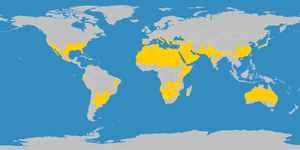
Subtropics
About this schools Wikipedia selection
This content from Wikipedia has been selected by SOS Children for suitability in schools around the world. Visit the SOS Children website at http://www.soschildren.org/
The subtropics are the zones of the Earth immediately north and south of the tropic zone, which is bounded by the Tropic of Cancer and the Tropic of Capricorn, at latitude 23.5 ° north and south. The term 'subtropical' describes the climatic region found adjacent to the tropics, usually between 20 and 35 degrees latitude in both hemispheres, but occasionally found at slightly higher latitudes.
In subtropical climates the winters are relatively warm, but not as hot as the summer season. These climates rarely - if ever - see frost or snow, and plants such as palm, citrus and many broadleaf evergreens flourish, in contrast to the hardier deciduous and coniferous trees which dominate midlatitude climates. As one moves toward the tropical side the slight winter cool season disappears altogether, while at the polar threshold of the subtropics the winters become much cooler.
Rainfall patterns vary widely throughout the subtropics including hot deserts, savannas, monsoon forests, humid forests and the warmer parts of the Mediterranean climate zone. Subtropical regions include the southern third of California (Mediterranean type), the low deserts of the Southwest USA (hot arid type), the Gulf Coast and most of Florida (humid type), the southern Mediterranean and northern Sahara, northern India ( monsoon), southeast China (humid), the middle part of South America (varied), and much of Australia (varied). Example of subtropical cities and areas include:
- Russia: Sochi
- Turkey: Mersin, Antalya, Rize
- Australia: Brisbane and Sydney
- Middle East:Jerusalem, Baghdad, Kabul, and Islamabad
- Europe: Lisbon, Barcelona, Rome, Dubrovnik, Athens and Sochi
- United States: Houston, Texas, Charleston, South Carolina, Orlando, Florida, Tucson, Arizona
- Brazil: São Paulo, Curitiba, Florianópolis and Porto Alegre
- North Africa: Cairo
- South Africa: Durban and East London
- New Zealand: Auckland
- Uruguay: Bella Unión
- China: Hong Kong, Macau and Shanghai
Subtropical flora
-
Savannah, Georgia: Live oak with spanish moss. This is a typical scene in the subtropical region of the eastern United States.



